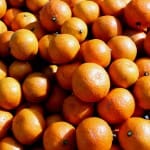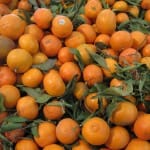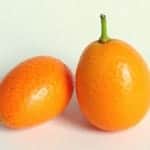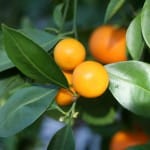Source(s): Gerard Krewer
With proper attention given to selection of the more cold hardy types of citrus, along with recommended care, this group of fruits may be successfully grown around homes in the coastal and extreme southern areas of the state and to a lesser degree in more northern locations.
Citrus plants are very versatile around the home and may be used as individual specimens, hedges or container plants. Their natural beauty and ripe fruits make them very attractive additions to the South Georgia home scene. Areas where citrus are best adapted within the state are generally south of a Columbus to Macon to Augusta line. The most significant limiting factor to citrus culture in these areas is the damage from severe winter temperature.
The three general types of citrus which produce sweet fruits are mandarins, sweet oranges and grapefruits. All of these citrus types develop into attractive, medium to large-sized trees. However, some are better adapted to South Georgia conditions than others.
MANDARINS
This citrus class includes a large group of loose skinned, deeply colored, highly flavored fruits. They are sometimes referred to as the kid-glove (easily peeled) fruits. Within this group are the mandarins, satsumas, tangerines and tangerine hybrids. The terms mandarin and tangerine are used interchangeably for a number of loose skinned fruits depending upon where they are grown. For example, Dancy is called a tangerine in Florida and a mandarin in California. Unlike other types of citrus, cross-pollination is required for optimum fruiting of a number of mandarine(tangerine) varieties and hybrids.
Satsuma
The highest degree of success and greatest satisfaction in growing citrus in Georgia will be realized with the satsuma. It will withstand colder temperatures than the other forms of edible sweet citrus, produce more consistent crops over a longer period of time and requires less cold protection.
The satsuma is distinctly different from the mandarin in a number of characteristics and is self-fruitful. It has excellent cold hardiness and ripens its fruit well ahead of any freeze problems(September-October). Owari is the most popular variety and is generally available at retail outlets. Fruits retain their peak quality for not much longer than two weeks, after which they become puffy, rough in appearance and lose flavor and juice content.
An important fact to remember when growing satsumas is that the fruits become fully ripened for eating while the peel color is still rather green. And certain fruits will ripen ahead of others. By beginning to harvest when the first few fruits become ripe, at least one to two weeks may be added to the length of the harvesting period.
Tangerines(Mandarin)
The next best type of citrus to plant from the standpoint of cropping and cold hardiness is the tangerine. Satsumas and tangerines will escape damage from many freezes which will severely damage grapefruit and sweet oranges. Dancy and Ponkan are exceptionally good tangerine varieties and produce quality fruits. However, their fruits may not develop good flavor before early to mid December, so fruits may be exposed to freezing temperatures before attaining optimum ripeness. The Ponkan reportedly is less cold resistant than most mandarins and fruits lose quality and the rind puffs if not picked when ripe. Earlier ripening selections should be planted where possible such as Clementine(Algerian) tangerine. Dancy and Ponkan are self-fruitful, but Clementine requires cross-pollination from another tangerine or tangerine hybrid. The tangerine hybrids described below provide some exceptionally good, early maturing varieties which should be of interest to the homeowner.
Tangerine Hybrids
Tangelos are tangerine-grapefruit hybrids which produce loose skinned, tangerine-like fruits. Orlando is an ideal selection for homeowner use. It is cold hardy and produces excellent quality fruits which ripen early(October-December). Dancy, Clementine, or some other variety should be planted with Orlando for cross-pollination. Other early season(October-December) tangerine hybrids which could be grown include Lee, Robinson, Osceola, Nova and Page. All of these hybrids require cross-pollination for best fruiting.
SWEET ORANGES
This type of citrus may be grown along the lower coastal area with a fair degree of success if adequate cold protection is provided each year. However, hard freezes(20 degrees F and lower) will severely damage them. Hamlin is suggested if fruits are desired primarily for juice. Fruits are commercially seedless (six seeds or less per fruit) and ripen early(October-November). Cold hardiness of Hamlin is equal to or superior to other sweet orange varieties.
The naval orange is recommended if the homeowner’s wish is to grow seedless fruit for eating fresh. It should be remembered that naval oranges often produce light crops and aren’t usually as fruitful as regular sweet orange varieties(non-navel types) such as Hamlin. Suggested varieties include Washington, Dream and Summerfield. All ripen their fruits relatively early(October-December).
GRAPEFRUIT
Because of a lack of outstanding cold hardiness, grapefruit should be grown along the lower coastal areas noted above for sweet oranges. Although numerous selections are available, the Marsh(white seedless) and Red Blush or Ruby (red seedless) varieties are the most frequently planted. Both produce excellent quality fruit and have few to no seeds. For those homeowners who prefer exceptionally high quality fruit, the white seed varieties Royal and Triumph are suggested. Fruits of Marsh and Ruby may be harvested as early as late September and October, but if allowed to remain on trees until November and December, eating quality significantly improves. The Star Ruby, released by Texas A&M University, appears to be the most outstanding red, seedless grapefruit presently available.
Resource(s): Citrus Fruits for Southern and Coastal Georgia
Center Publication Number: 169



